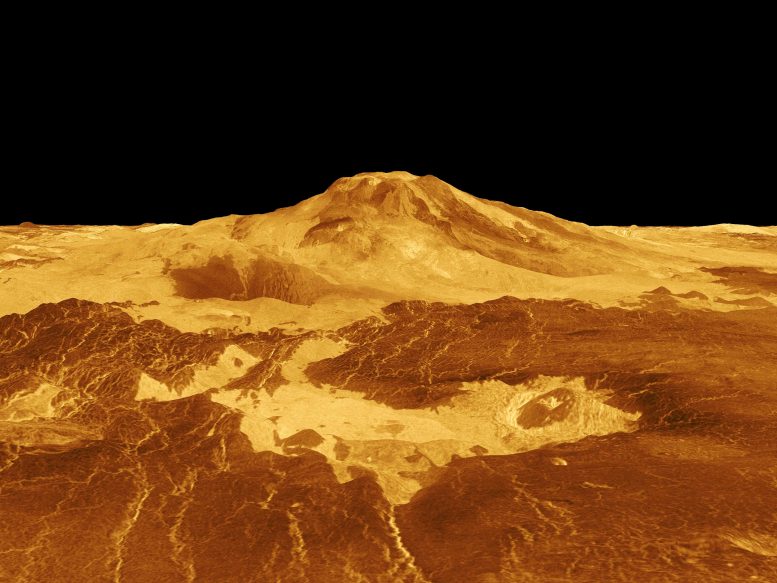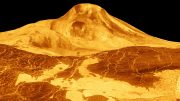
Maat Mons is displayed in this computer-generated, three-dimensional perspective of the surface of Venus. The viewpoint is located 634 kilometers (393 miles) north of Maat Mons at an elevation of 3 kilometers (2 miles) above the terrain. Lava flows extend for hundreds of kilometers across the fractured plains shown in the foreground, to the base of Maat Mons. NASA Magellan mission synthetic aperture radar data is combined with radar altimetry to develop a three-dimensional map of the surface. The vertical scale in this perspective has been exaggerated 10 times. Credit: NASA/JPL
Researchers analyzing Magellan spacecraft radar images discovered a changing volcanic vent on Venus, providing new evidence of active volcanism on the planet.
Researchers have identified evidence they interpret as active volcanism on the surface of Venus, according to a new analysis of radar images from the Magellan spacecraft. The images reveal a vent that changed shape on Venus, which they believe points to ongoing volcanic activity there.
Many volcanoes have been identified on the surface of Venus, but evidence of recent volcanic activity on the planet has been lacking. As a result, it was unknown whether the prominent volcanic features of Venus’ geologically young surface are a product of ongoing active volcanism or relics of ancient volcanic activity that has since ceased.
Although no volcano has been observed erupting on Venus, some previous research has suggested that ongoing volcanic activity might occur in various regions across the planet’s surface. However, geodynamic models of the planet produce different predictions for the current level of Venusian volcanism.
Robert Herrick and Scott Hensley have examined radar images of Venus’ surface collected by the Magellan spacecraft between 1990 and 1992, searching them for evidence of Venusian volcanic activity. During its mission, Magellan used radar to image the surface of Venus from different orbits, observing some locations two or three times over the course of two years, including areas later identified as potential locations for volcanic activity.
Because the data were not conducive to automated methods, Herrick and Hensley manually searched full-resolution radar images of these areas for changes in geologic features that occurred between Magellan’s radar imaging cycles.
The authors identified a volcanic vent – part of the larger Maat Mons volcano system – which appeared to grow larger and change shape between two Magellan radar images taken eight months apart. Changes to the adjacent surface could possibly have been caused by a lava flow emanating from the vent. Herrick and Hensley interpret the observed changes as indicating ongoing volcanic activity on Venus.
For more on this research:
Reference: “Surface changes observed on a Venusian volcano during the Magellan mission” by Robert R. Herrick and Scott Hensley, 15 March 2023, Science.
DOI: 10.1126/science.abm7735








Be the first to comment on "A Fiery Surprise: Magellan Spacecraft Uncovers Signs of Active Volcanism on Venus"